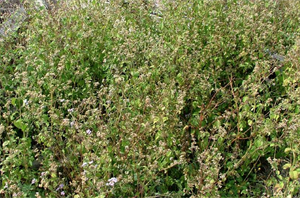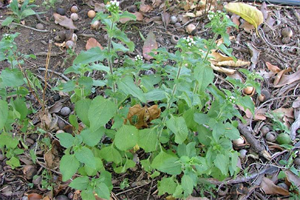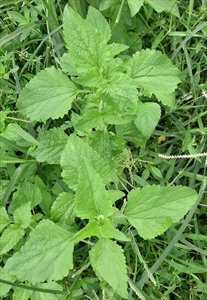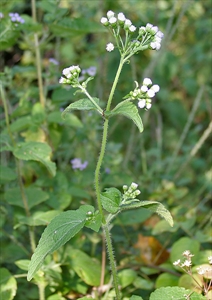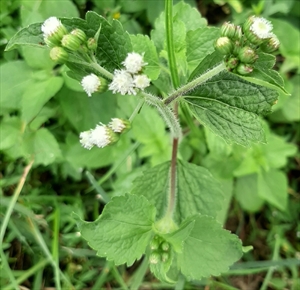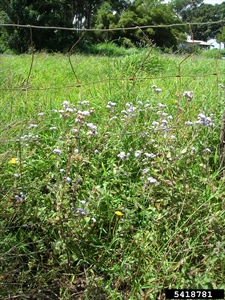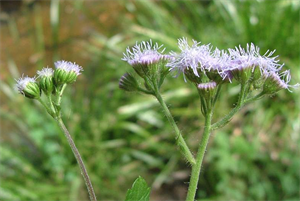Goatweed; it is also known as billygoat weed (or billy goat weed, even billy-goat weed), tropic ageratum, blue flowered groundsel.
Pacific Pests, Pathogens, Weeds & Pesticides - Online edition
Pacific Pests, Pathogens, Weeds & Pesticides
Goatweed (451)
Ageratum conyzoides; previously, known by a large number of different names in the genera Ageratum, Cacalia and Eupatorium. It is also said to be Ageratum conyzoides subspecies conyzoides. It is a member of the Asteraceae.
A similar species, Ageratum houstonianum, is recorded in the Pacific islands (Fiji, French Polynesia, New Caledonia, Papua New Guinea).
Asia, Africa, North, South and Central America, the Caribbean, Oceania. It is recorded from Australia, American Samoa, Cook Islands, Federated States of Micronesia, Fiji, French Polynesia, Guam, Kiribati, Marshall Islands, Nauru, New Caledonia, Northern Mariana Islands, Palau, Papua New Guinea, Samoa, Tonga, Vanuatu, and Wallis & Futuna.
A native of tropical America, South and possibly Central America, and the Caribbean.
A major invasive weed in many regions of the word, capable of covering extensive areas (Photo 1). It occurs in natural habitats - grasslands, forests, wetlands, banks of water courses, coastal dunes - and also in disturbed habitats associated with human activities: crops (light and heavy soils), pastures, plantations, orchards, wastelands and roadsides.
Goat weed prefers moist, fertile soils; it is not suited to the dry less fertile soils of atolls.
Goatweed is an annual, erect, branching herb, 0.5-1 m high (Photo 2). Stems are soft becoming woody with age. Leaves, oval, but broader at the base, up to 7.5 cm long (Photo 3). Both young stems and leaves are covered with fine white hairs. When crushed the leaves have the smell of a male goat, hence the name. Plants have 4-18 flowerheads in a branched flat-topped cluster at the top of the stems or less commonly from branches off the main stem (Photos 4&5). Within each flowerhead, there are 30-50 white, light blue or violet flowers (Photos 6&7). The individual flowerheads are surrounded by two to three rows of leaf-like structures (Photo 5). The fruits are small, brown and one-seeded (Photo 8). The plants have shallow fibrous roots.
Another species Ageratum houstoniarum is similar (Photos 9&10): it has a larger number of flowers in each flower-head, 75-100, compared to 60-75 in Ageratum conyzoides, and the female parts of the flower, the style, are clearly seen above the green leaf-like structures surrounding the groups of flowers (Photo 11).
Spread occurs associated with the trade in ornamental plants, which subsequently escape from gardens. The weed is also spread as a contaminant of seed of other species, and also on people's clothing as well as on machinery.
The impact from goatweed is both economic and environmental. It flowers year round, completes its life-cycle within 2 months, and produces large amounts of seed resulting in heavy infestations that lower crop yields, and are costly to control. Also, the growth of this weed over large areas (from coast to over 3000 masl) impacts biodiversity by preventing native species from establishing.
Goatweed is reported a problem in the following crops: maize (Ghana, Nigeria, the Philippines), peanut (Ghana, Indonesia, Sri Lanka), upland rice and chillies (Indonesia), cotton (Uganda), tea (Taiwan, India, Indonesia, Mauritius and Sri Lanka), cocoa (Brazil), potatoes (Colombia), oil palm (Nigeria), and over-grazed pastures (Australia, Hawaii, India). Yields are lower than expected, and labour costs for weed management are high.
It is poisonous to humans. Ingesting goat weed is said to cause liver lesions and tumours. There is a report of a mass poisoning in Ethiopia as a result of contamination of grain.
Goatweed hosts plant pathogens. For instance, it is a symptomless carrier of bacterial wilt (Ralstonia solanacearum), a host of the banana nematode (Radopholus similis), as well as the root knot nematatode (Meloidogyne javanica). There are reports as a host of virus diseases.
Probably, only eaten for medicinal purposes; the weed is used in many traditional medicines, covering a large number of common complaints. A wide range of chemical compounds including alkaloids, flavonoids, chromenes, benzofurans and terpenoids have been isolated from this species according to the IUCN. Insecticides and herbicides are included in the list of uses.
BIOSECURITY
There is a high risk of goatweed becoming an invasive weed when grown outside its natural range. Once established, it is extremely difficult to control. Countries not yet infested should consider all likely pathways for entry, and apply quarantine measures accordingly. Special consideration should be given to the part played in the spread of this weed by the domestic and international trade in ornamental plants, as well as its use in traditional medicines. Seeds can be bought on the internet..
Ageratum conyzoides is on the Global Invasive Species Database (2020) of information about alien and invasive species that negatively impact biodiversity, managed by the Invasive Species Specialist Group of the IUCN Species Survival Commission.
BIOLOGICAL CONTROL
Little known.
CULTURAL CONTROL
- Physical & Mechanical
- Hand weed (the weed is shallow rooted) where practical, before the plants have set seed. Follow-up as required.
- Plough and disc the land, preferably before the plants have flowered and set seeds. Goatweed needs light to germinate, so burying the seeds should control its germination.
- If practical, flood-fallow the land for a short period.
- Hygiene
- Treat vehicles and farm machinery. Wash down vehicles first before moving from areas where the weed occurs to those weed-free. Wash to remove soil and seed.
- Ensure seeds are not carried on clothes between infested and 'clean' areas.
CHEMICAL CONTROL
In Australia: glyphosate (and Fiji); glufosinate-ammonium, are registered. In Fiji, 2,4-D.
--------------------
Note, EU approval to use glyphosate ends in December 2022; its use after that date is under discussion.
____________________
When using a pesticide, always wear protective clothing and follow the instructions on the product label, such as dosage, timing of application, and pre-harvest interval. Recommendations will vary with the crop and system of cultivation. Expert advice on the most appropriate herbicides to use should always be sought from local agricultural authorities.
AUTHORS Grahame Jackson, Aradhana Deesh & Mani Mua
Adapted from Billygoat weed (Ageratum conyzoides) (2018) Weeds of SE Qld and Northern NSW. Lucidcentral. (https://www.lucidcentral.org/editors-pick-animal-and-plant-identification-keys/key-to-weeds-of-se-qld-and-northern-nsw); and additional information from CABI (2019) Ageratum conyzoides (billy goat weed). Invasive Species Compendium. (https://www.cabi.org/isc/datasheet/3572). Photos 1,2,5&10,11 Sheldon Navie, Queensland, Australia. Photo 4 Minghong Photo of Ageratum conyzoides. Photos 8&9 Forest & Kim Starr. Starr Environmental, Bugwood.org.
Produced with support from the Australian Centre for International Agricultural Research under project HORT/2016/185: Responding to emerging pest and disease threats to horticulture in the Pacific islands, implemented by the University of Queensland, in association with the Pacific Community and Koronivia Research Station, Ministry of Agriculture, Fiji.
